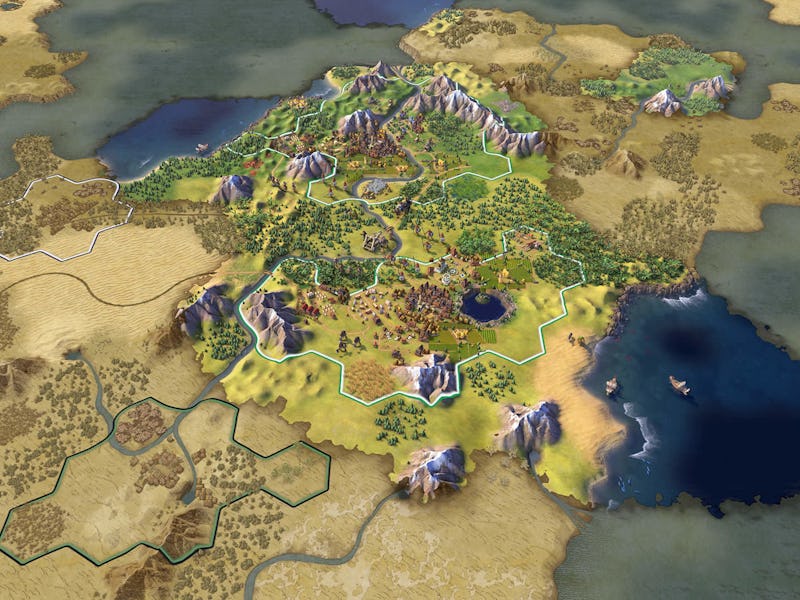The Evolution of 'Civilization' Over 25 Years
One of gaming's classic franchises continues to conquer.

Civilization might simulate the span of the imaginary history of the human race, but the series itself is also quite storied. With its roots set all the way back in 1991, Civilization made us reimagine the sheer scope of games, giving us the power to control our own cultures for thousands of years. It’s one of the longest-lasting franchises in gaming, yet it remains one of the most groundbreaking and influential strategy games to date. The history of Civilization is one of change.
'Civilization' lets you hobnob with famous historical figures.
Civilization, 1991
The series began with the aspirational but flawed Civilization that put both MicroProse and Sid Meier on the map. While the game was preceded by other notable strategy games, Civilization was the first to boast such scale and multilayered complexity. If you’re familiar with later entries in the series, the first entry laid the essential foundations. Players start off with a settler and begin building cities and researching new discoveries, like the wheel or writing. How people applied these technologies to both military and diplomatic situations added a further layer of strategy as you fought to conquer neighboring empires or stay on the cutting edge.
Spanning from 4000 B.C. to 2100 A.D., there was nothing quite like Civilization at the time. Military units would grow with your society, reflecting innovations in military strategy through the years, while the complex, diverging branches of the research tree heavily influenced the path your civilization would eventually take. Civilization had a strong influence on other important strategy games of the time, including Alpha Centauri and Age of Empires.
"Elvis" advises you across millennia in Civ 2 because the '90s.
Civilization II, 1996
In the eyes of MicroProse, Civilization II was a simple side project that would pale in comparison to their exciting follow-up to the original Civilization, CivNet. CivNet was essentially an online version of the first game, and, according to a report by Kotaku, MicroProse had high hopes for the project. The plan backfired, though. MicroProse putting all of their focus on CivNet gave developers Sid Meier, Bryan Reynolds, Jeff Briggs, and Douglas Kaufman free rein to make all sorts of creative developments in Civilization II. As a result, the game built on Civilization’s success while implementing new mechanics, effectively leaving CivNet in the dust. It was an instant hit and remains a fondly remembered classic.
Among other changes, Civilization II received an improved A.I. along with an isometric field of view. It also featured some oddball additions like the High Council, a group of advisers that tried to boss you around in a series of FMV cutscenes — truly a sign of the times. Others were purely cosmetic but added a nice touch of immersion. Upon beating the game, you’d receive a title depending on how you approached leadership, which is a feature that’s continued into recent entries in the series. Players could also upgrade their personal throne room and check out a bird’s-eye view of their cities to bask in all of the Wonders they’d built.
Civilization 3 saw that series's first attempts to modernize.
Civilization III, 2001
Civilization III’s biggest contribution to the franchise was the culture system, allowing you to spread your culture’s influence not just through military might or technological prowess, but also through cultural improvements. Building libraries, churches, and Wonders all contributed to your cultural influence. When that influence grew powerful enough, you could effectively expand your borders and conquer other cities. But otherwise, it’s not dissimilar from the previous entry.
Civilization IV, 2005
The series’s fourth iteration was also its biggest departure. Civilization IV got a huge makeover with its new graphics engine being built from scratch. Players could now zoom in on individual tiles — quite the shift from the simpler isometric design of the previous two entries. Smarter AI and a well-designed multiplayer, too, set Civilization IV apart from its predecessors. The game also garnered a lot of attention with its narration by Leonard Nimoy, not to mention its gorgeous theme song — “Baba Yetu” — which was the first video game track to win a Grammy award.
'Civilization V' got a dramatic facelift and important mechanical updates.
Civilization V, 2010
Civilization V switched from square tiles to a hexagonal grid, while the 3D graphics were now done up in a gorgeous, painterly style. However, the game’s combat got the biggest overhaul. Battles suddenly became much more strategic, as only one military unit could occupy a tile at a time. This required players to synchronize their combat movements carefully in a delicate, tactical dance. The expansions, Gods and Kings and Brave New World, threw in espionage mechanics and tourism to boot.
Now we await the arrival of Civilization VI, which looks to continue the legacy when it releases this Friday — the first full Civilization game since 2010. Sean Bean succeeds the late Leonard Nimoy as narrator, while yet again small but important details have been improved, including the A.I. and new multi-tile cities that include districts.
Apart from some small changes over the years, Civilization has remained essentially the same at its core, speaking to the game’s timelessness. Each entry in the series improved upon the last, cementing Civilization in the annals of video game history as one of the most well-loved strategy games.
Ghandi will probably still be a jerk in 'Civilization VI'.